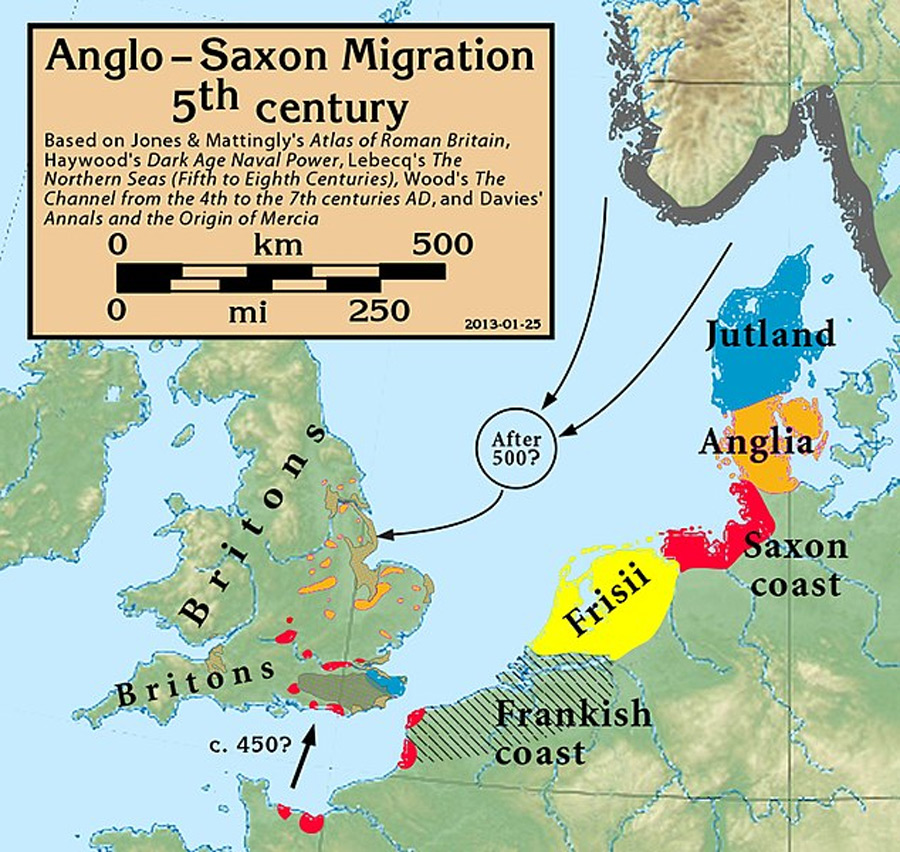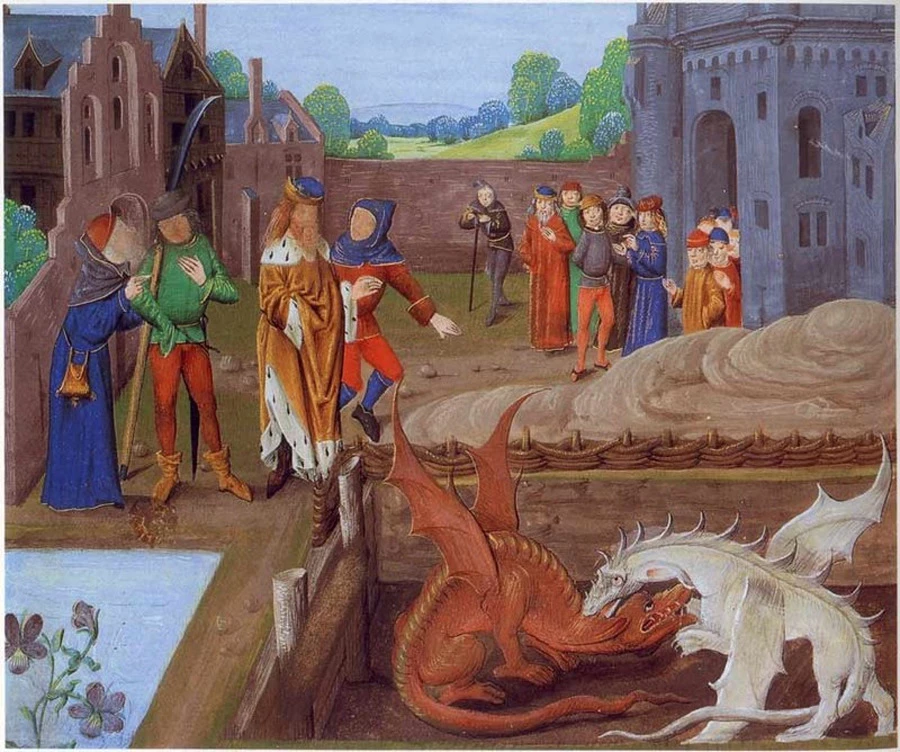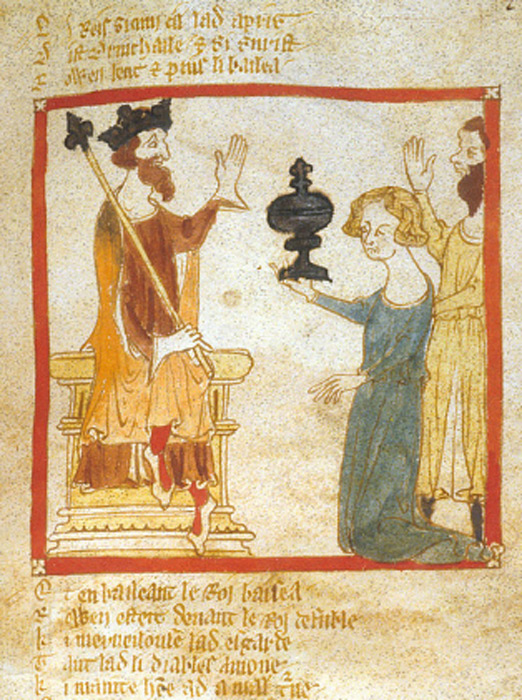Most mainstream historians have abandoned the search for King Arthur as a historical figure. The myths and stories which surround the legendary King of Britain, drawing on so many sources and written so long after the fact, have impossibly tangled the narrative and may have obscured the truth for all time.
However, this is not always the case for the world Arthur lived in, and the people with whom he interacted. Some of these figures from the legends are very likely to be real, and one of the most prominent is a King of the Britons who ruled before Arthur: King Vortigern.
What do we know about this ancient warlord? And can the knowledge of his reign lead us, in form if not in fact, to the world of King Arthur?
A Warlord and a King?
Unlike Arthur we have accounts of a king called Vortigern from more reliable and much earlier sources, known from other details to be accurate. The 6th century historian Gildas writes of him, as does the Venerable Bede in the early 8th century.
For them, Vortigern would have been no further than Victorian England, or the American Civil War is to a modern-day historian. And from them, and other accounts which draw from them, we are able to piece together a picture of this king and the world Arthur was born into.
Vortigern was a 5th century ruler in Britain, more a warlord at the head of an army than a settled “king”. Some even believe that Vortigern was not his actual name. It is viewed as a kind of title given to him by his contemporaries, as at the time the name literally meant “Overlord” or the “Great King”.
He is principally known for his struggles against the Scots and Picts of the far north, striking from Scotland. His decision, perhaps mad in desperation, to ally himself with the foreign Saxons against these raiders, would have far reaching consequences.
Having invited the Saxons to Britain to stop the incursions of the Scots and Picts, Vortigern in return gave them the power to take control of the land. The Saxons duly arrived, under their leaders Hengist and Horsa. And they have been in the British Isles ever since.

Hengist and Horsa, arriving in the far south east of the Kingdom of Britain, were only the first wave of a great migration of Vikings and Norsemen from Scandinavia across the sea. The great Saxon push west, and the resistance of the native Britons led by Arthur, is the central theme of the Arthurian legends.
- Was King Arthur Real? Examining the Historical Record
- The Legendary Geats: What Happened to Beowulf’s People?
As for Vortigern, he was betrayed by the Saxon invaders. They slaughtered his son and heir and established their own kingdom, in what is now Kent. In time, the Saxon spread across all of southern England would be complete.
A Desperate Leader
In fact, much of what survives of Vortigern does not paint him as a powerful man. There are a number of sources according to which Vortigern is considered to be weak and of little character. If the sources are to be believed, it is quite hard to imagine how Vortigern came to power.
Vortigern may likely have gained the throne by murder and treachery, as such bloodshed was common at the time. However the only detailed description of his rise to power comes from Geoffrey of Monmouth in his “History of the Kings of Britain” and this has its own problems.
Geoffrey states that King Constantine had three sons, namely, Aurelius Ambrosius, Constans, and Uther Pendragon. A Pictish assassin killed King Constantine, and his eldest son, Constans, was set to inherit the king’s throne.
As Constans was very young, Vortigern took the opportunity to become the king’s advisor and later conspired to kill the young king. Vortigern convinced Constans to leave his monastery and claim the throne. But Constans was known to be an unpopular and weak puppet monarch.
So, Vortigern ruled the country until eventually he had Constans killed. After removing Constans from his way, Vortigern took the crown and became the king as he knew Aurelius Ambrosius and Uther Pendragon were too young to take the position.
The problem with this narrative? The source is one and the same with the tales of Arthur, and Geoffrey was writing in the 12th century, 700 years after Vortigern had lived and died. His account is pseudohistorical at best, and this information can be trusted no more than any other tale of Arthur.
Searching For the Historical Vortigern
It seems clear that anything Geoffrey wrote about Vortigern cannot be trusted, unless there is a corroborating source. After all, Geoffrey must have derived his “History” from somewhere. So what do other sources have to say about Vortigern?
Gildas provides the earliest source for Vortigern, and it is he that recorded his decision to invite the Saxons in order to halt the raids of Scots and Picts. Gildas does not refer to him as “Vortigern”, instead using the phrase “Supreme Lord” which may in fact be a synonym. He also blamed him for the subsequent Saxon invasion.
Bede is the historian who first called him “Vortigern” and also held him responsible for the Saxons. Bede also supplies the dates of his reign, through a passing mention of the concurrent Roman Emperor whose dates are well known.

However the characteristics of the man himself are absent from these two accounts and only come to light with much later writings. While it seems a minor narrative leap to classify a man who invited Saxons to invade and conquer his island home as “weak willed” there may be other, early sources which are now lost that provide this detail.
- Searching for Camelot: The Truth Behind the Court of Arthur
- What Can We Know about the Poet Who Wrote Gawain & the Green Knight?
There is however a source for Vortigern which predates much of the later Arthurian additions. The “History of the Britons” written in the 9th century by a monk named Nennius, although an unreliable source, is closer to the time period than almost anything else that speaks of Arthur and the world he lived in.
Nennius is not impressed by Vortigern, to whom he attributes multiple sins and personality flaws. He also suggests that Vortigern’s son, Vortimer, had successfully driven the Saxons from the British Isles once before, only to have them return at Vortigern’s request.
Vortimer is an interesting character in this light, and shares many characteristics which are later attributed to Arthur. He is a capable military leader and the son of a “High King” who raised a fierce resistance against the Saxons, just as Arthur did. Could there be a kernel of the story of Arthur here?
Later Traditions
Later accounts should be approached with caution, especially where the information they contain does not exist in earlier sources. Pseudohistorians such as Geoffrey of Monmouth were writing for the world they lived in, emphasizing chivalric values which were prominent for his 12th century audience, rather than his 5th century characters.
In his “History of the Kings of Britain” Geoffrey mentions that Vortigern invited the Saxons but was not able to control them right from the beginning. In fact, Hengist manipulated the king and introduced him to his young and beautiful daughter named Ronwen.

At a great feast, Vortigern was induced to drink a great deal and in his drunkenness encouraged to think of marrying Ronwen. Finally, Vortigern married Ronwen, and the power (and demands) of Hengist increased.
The “Anglo-Saxon Chronicle”, written in the 9th century, provides a little more evidence. This account mentions the dates as well as locations of the four battles that Horsa and his brother, Hengist, fought against Britain. Vortigern is believed to have been the British commander in one of these battles, the first. After 455 AD, Vortigern disappears from the narrative.
All other sources mention Vortigern in passing, or are much later and can be considered to be largely fictional. But given the many references to such a king it seems clear that there was some historical basis for this King.
We know that the Saxons invaded Kent and the east coast of England. We know that, after a fierce struggle against the natives they were successful, as wave after wave of settlers arrived, in conquering much of southern England.
Do we perhaps, in the accounts of Vortigern, know why as well?
Top Image: How much of Arthur can be found in the history of Vortigern? Source: Fotokvadrat / Adobe Stock.
By Bipin Dimri